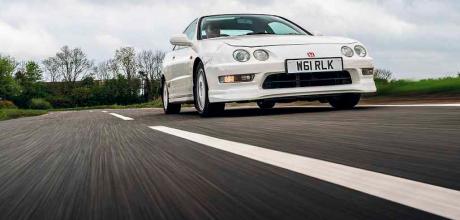Staving off dis-Integration 2000 Honda Integra Type R

The Integra has been driving better than ever this summer, and the air-con has proved an effective heatwave antidote. Now it’s time for some long-awaited TLC.
Keeping on top of rust is a key part of DC2 ownership. This one has been well maintained, but the previously repaired rear wheelarches were starting to bubble up again when I bought the car. This had barely changed a year later, but a further year on, the driver’s side ’arch is looking considerably more troubling. I’d planned to get the wheelarches sorted out soon after buying the Integra, but I guess I was just having too much fun driving it. Kicking the can down the road is never the best idea, though, so I contacted a few of my usual body shops. Most were booked solid for three months or more, so it would be a while before the wheelarches could be made well again.
I took the Honda when I was helping out on last month’s M3 CSL photoshoot with Jordan Butters, who took the lead pic above. As I turned round in a nearby industrial estate, I spotted several interesting Japanese classics and various older Fords outside a small industrial unit. All looked immaculate, so as soon as I’d finished on the shoot I went back for a closer look. It turned out to be a small father-and-son body shop, Platinum Paintworks, and after I’d chatted with the son (who’s very much into Japanese classics) we took a look at the Honda’s arches. His thoughts echoed my own: the previous repairs had held up well, but now was the time to strip them back and do them again. He had a great attitude and filled me with confidence, so I booked it in there and then. Of course, there will be a three-month wait…
Last time I mentioned an ABS fault, which I thought would be an easy fix. Checking the fault codes (done by jumping two pins on the diagnostic port, which gives a flashing code on the dash) revealed a problem with the left front ABS sensor. I’ve done this so often that I was over-confident in my diagnosis, so I didn’t bother to check the resistance reading of the sensor before ordering a new one. Which was a mistake.
What I hadn’t twigged was that every ABS fault code the car had ever had was apparently still stored in the system. Had I waited for the blinking light to complete its cycle, no fewer than ten fault codes would have flashed up. Clearing them involves turning the ignition on then pressing the brake pedal when the light flashes on/off. Now one code remained: the right rear sensor.
Finding a front sensor was easy, but a rear? No chance. Honda’s supplies of these dried up years ago, and remaining new ones change hands for £400-plus. Secondhand items are a bit of a lottery but still sell for £70 or more. An eBay search revealed that a UK-based company, R-Motion, sells a custom-built cable for £185: not cheap, but good value next to other options and a small price to pay for working ABS. Mike at R-Motion even got in touch with handy tips for swapping it over without causing any further headaches.
Above Custom-made rear ABS sensor has fixed what had become quite a worry.

